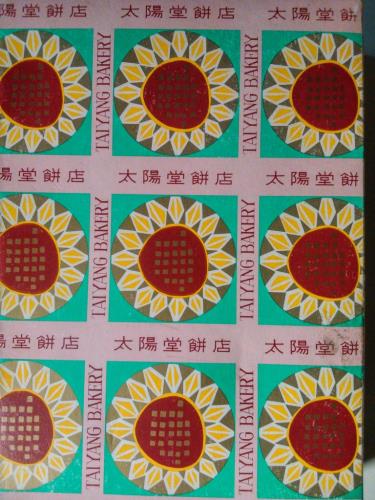Consultant of Bai-mi Wooden Clog Village in Su’ao, specialist/lecturer of Yu Yu Yang Museum, Marketing Manager of Lee Gallery.

Sunflowers used to be the icon of Tai Yang Tang Bakery Photo provided by the author
When I was young, each time my relatives visited me they would bring a box with sunflowers printed on it, filled with pastries that were just the right sweetness. That taste is unforgettable. Now, almost all visitors who go to Taiwan buy a box of these “sun cakes,” but what is so special about them?
Sun cakes were invented a long time ago in a town in Taichung, in a bakery called Tai Yang Tang run by a couple. They decided to reinvent a classic Taichung cake made of malt into a crumbly cake with a rich filling inside, and wanted to open a new shop in the city. They enlisted the help of an old friend, Yen Shui-long, who advised the couple to call the snack “sun cake”.
Yen (1903–1997) was born in Tainan and grew up with his grandmother and sister. He later studied at the Tokyo School of Fine Arts. He went to France in 1929, when one of his works, Parc de Montsouris, made it into the Salon D’Automne. He also studied at a crafts school, paving the way for his future career in crafts, advertising and design. Yen taught many students and built a solid foundation for the development of creative industries in Taiwan.
Influenced by Yanagi Soetsu, the father of Japan’s “folk craft” movement, Yen started to emphasise the weaving and sculpting culture of Taiwan’s aborigines. He improved upon the designs of straw mats and hats made in the central district of Dajia and then sold them elsewhere, bringing extra income to the communities there. He made bamboo wicker chairs and designed other furniture without the use of a single nail, using only bamboo sticks. Yen’s creations were both beautiful and environmentally friendly. He was a true pioneer in the art of living a beautiful life.
When Yen studied in Japan, he was influenced heavily by Gauguin and Van Gogh, so many of his paintings depict Taiwanese aborigines or sunflowers. The name “sun cake” and the patterns and colours on the packaging are also reminiscent of the bamboo crafts promoted by Yen. The blue and white background looks like the sky and each side of the box features different sunflowers. The colours are lucid, the composition is detailed and the box exudes feelings of sunshine, passion and vitality. The package is at once elegant and modern. Being the 1960s, Yen was clearly at the vanguard of design.
When the old Tai Yang Tang Bakery was still in operation, you could see a mosaic of ten sunflowers made by Yen. It was a beautiful piece of art, but during martial law, the police wanted to destroy it for political reasons. Luckily the owner of the store covered up the mosaic, allowing it to see the light of day again in 1995.
Yen’s designs span everything from neckties, coffee mugs, screens, furniture and advertising to large mosaic art pieces. He wanted everyone no matter rich or poor to have the opportunity to appreciate art. He also enthusiastically promoted bringing art into everyday life, and left his mark at design institutes all around Taiwan. I am sure that Yen will be heartened if he knows that thanks to his artistic involvement, sun cakes are not only one of the most popular tourist souvenirs in Taiwan, but are also the pride of Taiwan’s creative industry.
Though the original Tai Yang Tang closed its doors the year before last when its second-generation owner passed away, nine masters from the store decided to re-open for business, keeping alive the taste and spirit of sun cakes.